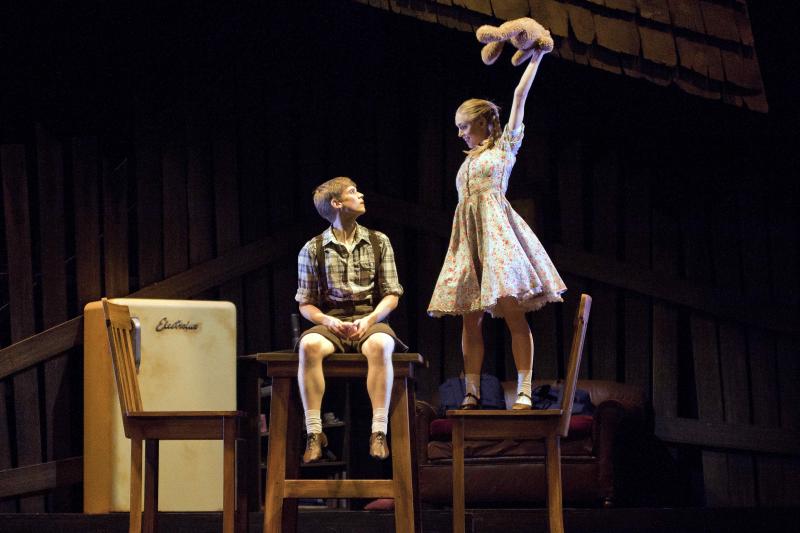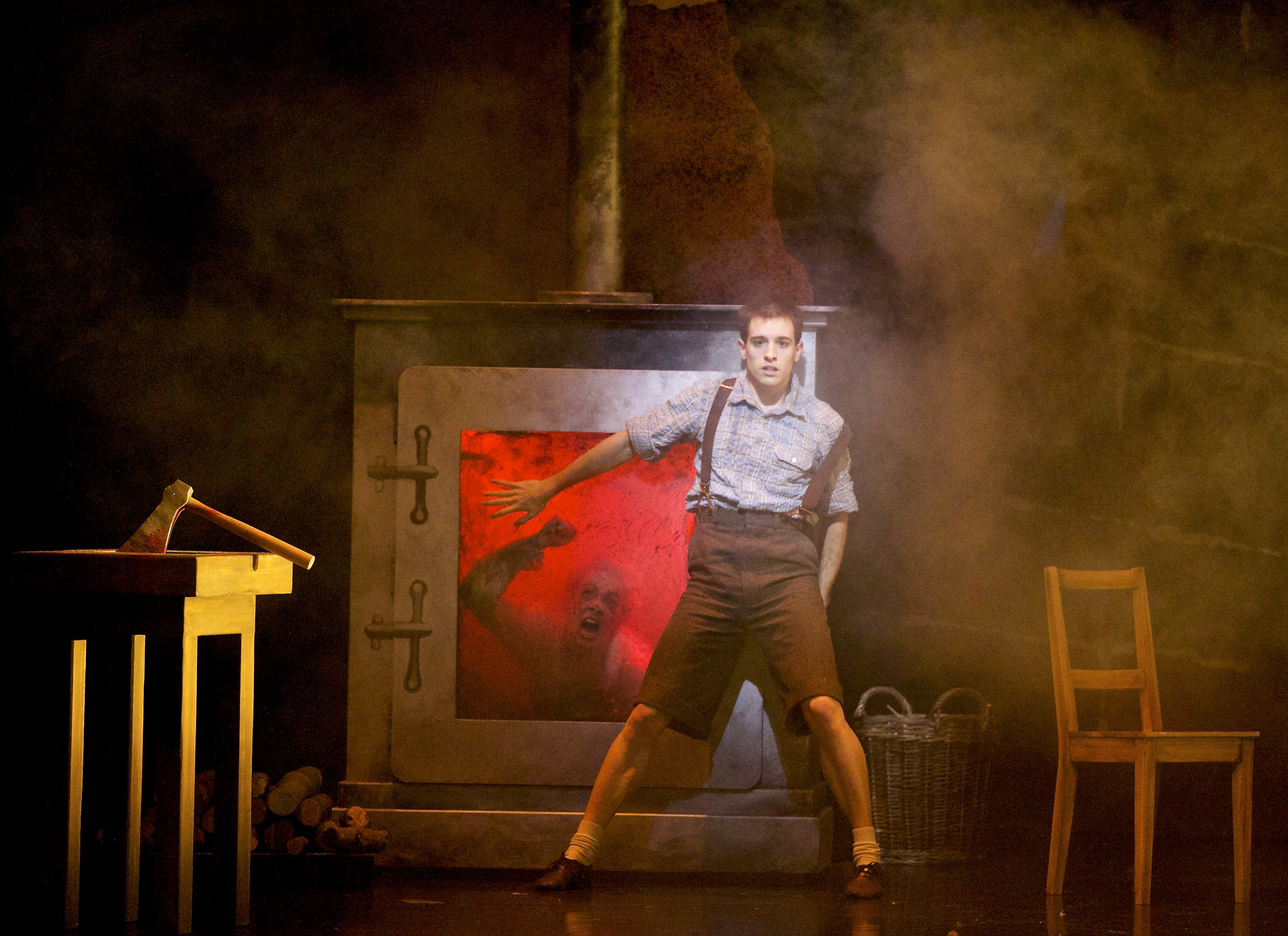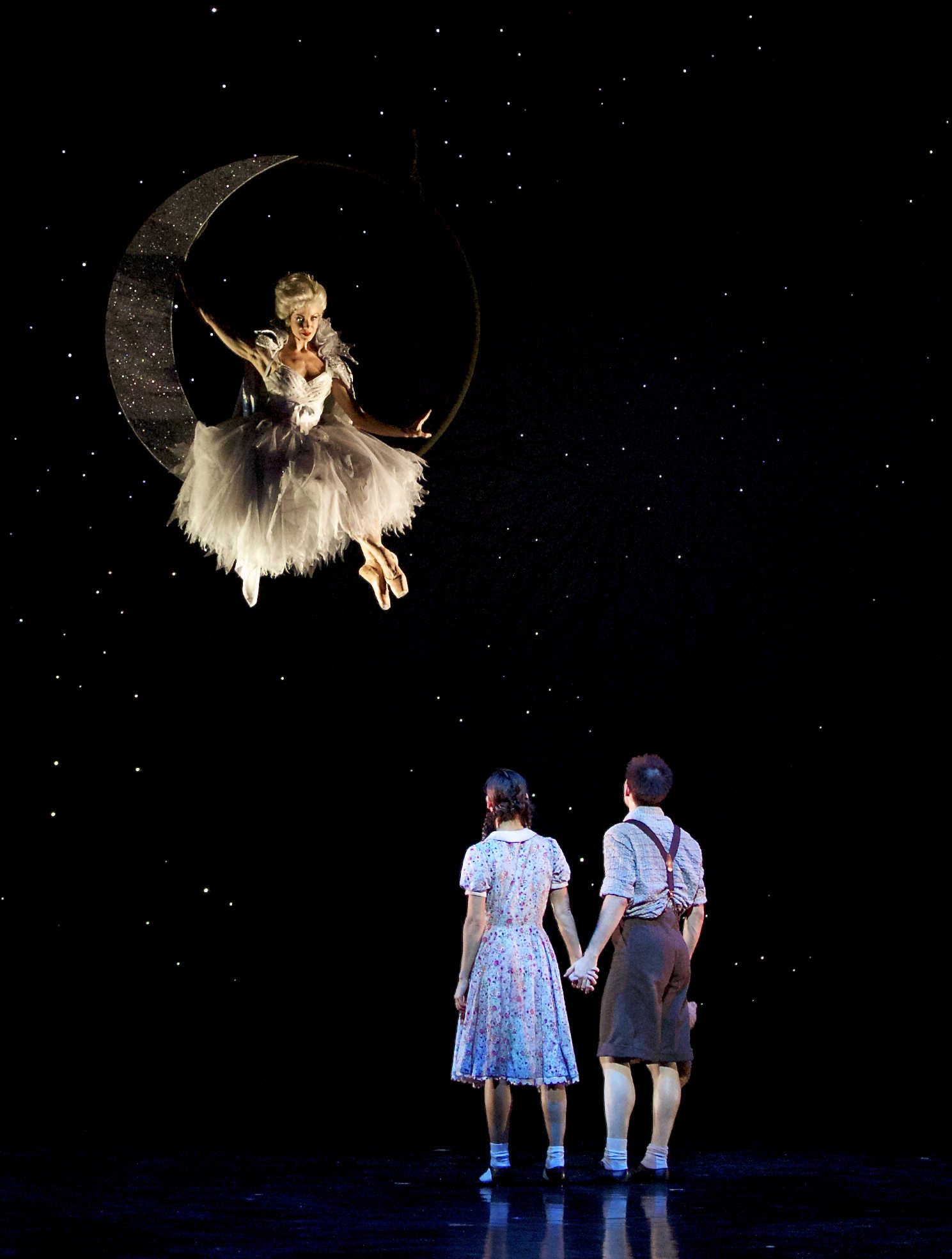Hansel and Gretel, Scottish Ballet, Theatre Royal, Glasgow | reviews, news & interviews
Hansel and Gretel, Scottish Ballet, Theatre Royal, Glasgow
Hansel and Gretel, Scottish Ballet, Theatre Royal, Glasgow
Sugar-coated new Christmas show looks good, but lacks bite

When he became Artistic Director of Scottish Ballet in 2002, Ashley Page’s first creation for the company was a witty, pacy, Nutcracker, the kind of box-office friendly production all companies need to win the hearts of the public and stabilise the finances.
Aiming squarely at the family market, Hampson - following Engelbert Humperdinck, from whose 1893 opera much of the ballet’s music derives - removes what is perhaps the scariest element in the Grimms’ original tale, the deliberate abandonment of the two children by their parents; instead, his Hansel (Jamiel Laurence) and Gretel (Constance Devernay) have a happy home life in a slightly jollified version of 1950s small-town Scotland, skilfully evoked by Caro Harkness’s costumes. All the evil they encounter is in the outside world, where the town’s children are disappearing and a glamorous schoolteacher (the gorgeously enticing Sophie Martin) is handing out lollipops.
Curiosity, rather than hunger or fear, leads Hansel and Gretel to leave home (where Quenby Hersh’s floral-apronned Mother and Remi Andreoni’s beer-swilling Father are contentedly snoozing on the sofa), but once outside they are menaced by the Ravens, three leather-jacketed rockers who later glam up with black feathers, and lured into the forest. The Ravens eat the crumbs Hansel drops to try and mark the way home, and when the exhausted children fall asleep (at the behest of a Sandman, Erik Cavallari), they dream of their parents at a ball, then of a banquet with chefs and waiters aplenty (finally! Something for the corps de ballet to do!). After being woken by a Dewdrop Fairy (Laura Joffre), they end up in a gingerbread house where – surprise! - the glamorous schoolteacher turns out to be a wicked witch and...well, you know the rest.
 Despite a couple of chilling moments, mostly courtesy of Gary Harris’s designs (the bloody axe stuck in a butcher’s block is a highlight, as is the witch’s fiery end in the oven, both pictured left), this is Grimm-lite. Parents may be grateful for the lack of nightmare fodder, but for adults it is sadly bland. I hold Humperdinck’s music largely responsible, tuneful and harmonious though it is, and delicately coloured by the Scottish Ballet orchestra under Richard Honner’s baton. Hampson, Honner and Brian Prentice selected and arranged the music from Hänsel und Gretel, padding it with passages from Humperdinck’s other compositions, and if the resulting score is to be believed, 95% of the German’s oeuvre was 4/4, mezzo forte, and 60 beats a minute, with neither pizzazz, passion, or pace for dancers to exploit. With a score this anodyne, it’s very hard to evoke evil, fear or the joy of reunion, and there are no exhilarating dance setpieces like Tchaikovsky’s flower waltzes to lift the spirits.
Despite a couple of chilling moments, mostly courtesy of Gary Harris’s designs (the bloody axe stuck in a butcher’s block is a highlight, as is the witch’s fiery end in the oven, both pictured left), this is Grimm-lite. Parents may be grateful for the lack of nightmare fodder, but for adults it is sadly bland. I hold Humperdinck’s music largely responsible, tuneful and harmonious though it is, and delicately coloured by the Scottish Ballet orchestra under Richard Honner’s baton. Hampson, Honner and Brian Prentice selected and arranged the music from Hänsel und Gretel, padding it with passages from Humperdinck’s other compositions, and if the resulting score is to be believed, 95% of the German’s oeuvre was 4/4, mezzo forte, and 60 beats a minute, with neither pizzazz, passion, or pace for dancers to exploit. With a score this anodyne, it’s very hard to evoke evil, fear or the joy of reunion, and there are no exhilarating dance setpieces like Tchaikovsky’s flower waltzes to lift the spirits.
 With so little help from the music, it’s all up to the dancers to shape the emotional story arc, and they do their best, with Constance Devernay’s Gretel a particular star for her fresh energy and expansive jumps. Hampson’s choreography of the storytelling/acting sequences is rather good: fluid, expressive and contemporary. But many of his danced variations have an exam-board quality, as if the dancers are being required to tick off things they can do (move on straights and diagonals, turn left and right, beat front and back), and Hampson is obviously fond of awkward morsels like developpés out of posé turns. Perhaps because only turgid music accompanies these technical challenges, there were stumbled landings and clumsy turns galore last night, even from principals.
With so little help from the music, it’s all up to the dancers to shape the emotional story arc, and they do their best, with Constance Devernay’s Gretel a particular star for her fresh energy and expansive jumps. Hampson’s choreography of the storytelling/acting sequences is rather good: fluid, expressive and contemporary. But many of his danced variations have an exam-board quality, as if the dancers are being required to tick off things they can do (move on straights and diagonals, turn left and right, beat front and back), and Hampson is obviously fond of awkward morsels like developpés out of posé turns. Perhaps because only turgid music accompanies these technical challenges, there were stumbled landings and clumsy turns galore last night, even from principals.
It’s only fair to acknowledge that I saw the third cast, the ones who normally do matinées for the under fives, and the story may well be more compelling as danced by the first cast, on whom it was created (Constant Vigier as Hansel, Sophie Martin as Gretel, the fantastic Eve Mutso as the Witch, pictured above right). But even the most charismatic actors and assured dancers will struggle to make up for the fundamental lack of excitement in both music and choreography. This is a good starter ballet for the uninitiated – easy on the ear, easy on the eye, clear story – and I hope it does well at the box office, but for me, this gingerbread fairytale is just too vanilla.
- Hansel and Gretel is at the Theatre Royal, Glasgow until 28 December, then goes on tour to Edinburgh, Aberdeen, Inverness, Newcastle and Belfast from 8 January to 8 February
rating
Buy
Explore topics
Share this article
The future of Arts Journalism
You can stop theartsdesk.com closing!
We urgently need financing to survive. Our fundraising drive has thus far raised £49,000 but we need to reach £100,000 or we will be forced to close. Please contribute here: https://gofund.me/c3f6033d
And if you can forward this information to anyone who might assist, we’d be grateful.

Subscribe to theartsdesk.com
Thank you for continuing to read our work on theartsdesk.com. For unlimited access to every article in its entirety, including our archive of more than 15,000 pieces, we're asking for £5 per month or £40 per year. We feel it's a very good deal, and hope you do too.
To take a subscription now simply click here.
And if you're looking for that extra gift for a friend or family member, why not treat them to a theartsdesk.com gift subscription?
more Dance
 'We are bowled over!' Thank you for your messages of love and support
Much-appreciated words of commendation from readers and the cultural community
'We are bowled over!' Thank you for your messages of love and support
Much-appreciated words of commendation from readers and the cultural community
 A Single Man, Linbury Theatre review - an anatomy of melancholy, with breaks in the clouds
Ed Watson and Jonathan Goddard are extraordinary in Jonathan Watkins' dance theatre adaptation of Isherwood's novel
A Single Man, Linbury Theatre review - an anatomy of melancholy, with breaks in the clouds
Ed Watson and Jonathan Goddard are extraordinary in Jonathan Watkins' dance theatre adaptation of Isherwood's novel
 Peaky Blinders: The Redemption of Thomas Shelby, Rambert, Sadler's Wells review - exciting dancing, if you can see it
Six TV series reduced to 100 minutes' dance time doesn't quite compute
Peaky Blinders: The Redemption of Thomas Shelby, Rambert, Sadler's Wells review - exciting dancing, if you can see it
Six TV series reduced to 100 minutes' dance time doesn't quite compute
 Giselle, National Ballet of Japan review - return of a classic, refreshed and impeccably danced
First visit by Miyako Yoshida's company leaves you wanting more
Giselle, National Ballet of Japan review - return of a classic, refreshed and impeccably danced
First visit by Miyako Yoshida's company leaves you wanting more
 Quadrophenia, Sadler's Wells review - missed opportunity to give new stage life to a Who classic
The brilliant cast need a tighter score and a stronger narrative
Quadrophenia, Sadler's Wells review - missed opportunity to give new stage life to a Who classic
The brilliant cast need a tighter score and a stronger narrative
 The Midnight Bell, Sadler's Wells review - a first reprise for one of Matthew Bourne's most compelling shows to date
The after-hours lives of the sad and lonely are drawn with compassion, originality and skill
The Midnight Bell, Sadler's Wells review - a first reprise for one of Matthew Bourne's most compelling shows to date
The after-hours lives of the sad and lonely are drawn with compassion, originality and skill
 Ballet to Broadway: Wheeldon Works, Royal Ballet review - the impressive range and reach of Christopher Wheeldon's craft
The title says it: as dancemaker, as creative magnet, the man clearly works his socks off
Ballet to Broadway: Wheeldon Works, Royal Ballet review - the impressive range and reach of Christopher Wheeldon's craft
The title says it: as dancemaker, as creative magnet, the man clearly works his socks off
 The Forsythe Programme, English National Ballet review - brains, beauty and bravura
Once again the veteran choreographer and maverick William Forsythe raises ENB's game
The Forsythe Programme, English National Ballet review - brains, beauty and bravura
Once again the veteran choreographer and maverick William Forsythe raises ENB's game
 Sad Book, Hackney Empire review - What we feel, what we show, and the many ways we deal with sadness
A book about navigating grief feeds into unusual and compelling dance theatre
Sad Book, Hackney Empire review - What we feel, what we show, and the many ways we deal with sadness
A book about navigating grief feeds into unusual and compelling dance theatre
 Balanchine: Three Signature Works, Royal Ballet review - exuberant, joyful, exhilarating
A triumphant triple bill
Balanchine: Three Signature Works, Royal Ballet review - exuberant, joyful, exhilarating
A triumphant triple bill
 Romeo and Juliet, Royal Ballet review - Shakespeare without the words, with music to die for
Kenneth MacMillan's first and best-loved masterpiece turns 60
Romeo and Juliet, Royal Ballet review - Shakespeare without the words, with music to die for
Kenneth MacMillan's first and best-loved masterpiece turns 60
 Help to give theartsdesk a future!
Support our GoFundMe appeal
Help to give theartsdesk a future!
Support our GoFundMe appeal

Add comment